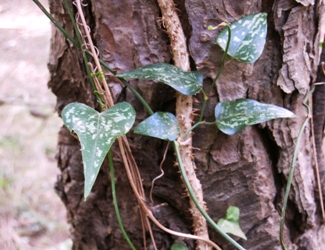The Rough Bindweed, good for cleaning contaminated soil

Selection of appropriate plant species is a bottleneck in phytoremediation of metal contaminated soils. Phytostabilization focuses on plants that restrict metal transport to shoots and efficiently cover the contaminated area thus avoiding dispersion of the contamination and improving visual impact.
A pre-requisite for useful plants in all case is high resistance to the relevant metals and an excellent adaptation to the other harsh soil conditions usually found in areas affected by mining activities, such as extreme pH, low organic matter, bad soil structure, and low water availability. Phytoremediation of the multiple metal contaminated sites in the Mediterranean area needs plants adapted to its special climatic conditions with hot dry summers and mild winters. Salt tolerance can be an additional demand, especially in coastal areas.
Mediterranean shrubs have deserved special attention because of their higher biomass, and better water use efficiency, indicator of resistance to low water availability, in comparison to herbaceous species. Rough Bindweed (Smilax aspera L.) a sclerophyllous vine typically present in Mediterranean shrubland has been reported at different metal contaminate sites. However, in contrast to shrub genus like Cistus, Rosmarinus or Myrthus there is scarce information on the mineral composition of this climber in relation to soil type properties.
Here we report on the leaf metal concentrations in Rough Bindweed plants growing on soils differing in metal burdens. At the mining sites Silene sclerocarpa Dufour plants growing in close contact to Rough Bindweed were found. Silene species are well known metal-resistant herbs that are able to efficiently exclude the metals from their shoots. As roots of both species Rough Bindweed and Silene apparently grew in the same soil portions, leaf metal concentrations were also determined in S. sclerocarpa as an in situ reference for metal exclusion ability. Advantages and disadvantages of Rough Bindweed for phytoremediation are discussed.
Three sites with different metal burdens from an ancient lead/barite mine called “Mina Maria” located in Mont-ràs in the Gavarres Mountains in Catalonia (NE Spain) were selected: a control site outside the mine spoil area (MMC), a site with moderate metal burdens (MM1) and a highly polluted site (MM2). As even outside the actual mining area (site MMC) plants were found to contain metal burdens higher than usually reported for background, Rough Bindweed plants were also sampled in a second control area (CC) with similar soil characteristics to the soils from the mining area, but not influenced by metal pollution, located in the Cap de Creus.
Rough Bindweed is significantly more efficient in metal exclusion from the leaves than Silene sclerocarpa. The low accumulation of Pb, Ba, Zn, and Cd in leaves of Rough Bindweed growing on soils with high metal burdens indicates low danger of food chain transfer of heavy metals from this species to herbivores. This property, in addition to the fact that S. aspera is very well adapted to Mediterranean climate conditions, makes it an interesting species for phytostabilization of metal contaminated soils in the Mediterranean area. However, more investigations addressing growth rate, surface cover, and interactions with other potentially useful species for soil phytorestauration in the Mediterranean area should be performed.
References
C. Poschenrieder, M. Llugany, A. Lombini, J. Bech , J. Barceló (2012) Smilax aspera L. an evergreen Mediterranean climber for phytoremediation. Journal of Geochemical Exploration 123: 41-44.


